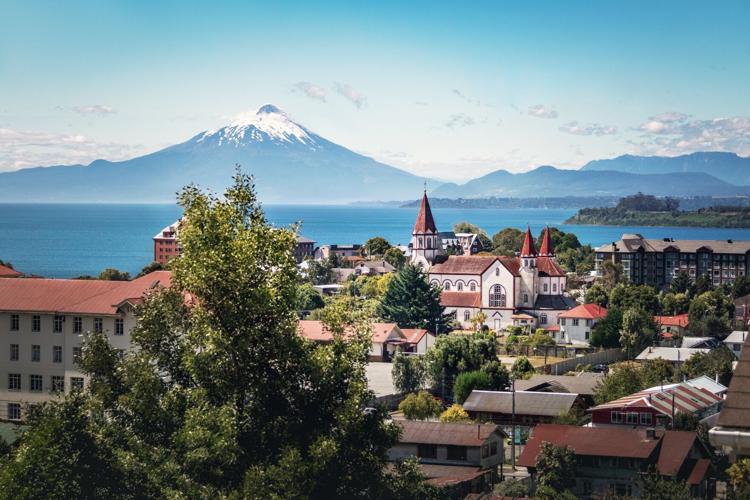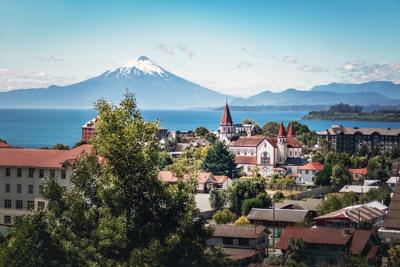Basilio Reinike, a seasoned expedition guide, unfolds a map of Chile’s Lake District. He pops off the cap of a red marker and circles a river famed for its whitewater rafting. Then he circles a volcano with good hiking trails. Then a rainforest boasting some of the oldest trees on the planet.
Pretty soon, the map looks like it has measles. It‚Äôs covered in red circles, each one promising a unique adventure. ‚ÄúYou can see we have many options,‚ÄĚ says Reinike, the head guide at . He continues to draw more red circles as I sip a pisco sour made with sweet, local murta berries and try, unsuccessfully, to control my FOMO.
I’ve just arrived at the boutique hotel perched on the edge of Lake Llanquihue. The second-largest lake in Chile, Llanquihue is one of several sparkling bodies of water that give this scenic region its name, Los Lagos.

Lake Llanquihue ranks as the second-largest lake in Chile.
SernaturLos Lagos is at the southern end of the Lake District, a term that‚Äôs sort of like calling a gourmet charcuterie board a cheese plate. The offerings in this northern gateway to Patagonia, roughly 1,000 kilometres south of Santiago, go well beyond its lakes. The supporting cast includes snow-capped volcanoes, ancient forests and fingerlike fjords sandwiched between the Pacific Ocean and the foothills of the Andes ‚ÄĒ features that are every bit as stunning as its deep glacial pools.
It’s an epic outdoor playground, and Hotel Awa is positioned to make the most of it. The property sits on a secluded stretch of shoreline not far from the adventure hub of , an adorable resort town settled by German immigrants in the 19th century. From this vantage point on the lake, guests can take in dramatic views of the perfectly cone-shaped Osorno volcano looming in the distance.

Hotel Awa’s guests can take in dramatic views of the Osorno volcano in the distance.
Hotel AwaThe hotel’s owners, Chilean architects Mauricio Fuentes and Jimena Hernández, first visited Puerto Varas while honeymooning in 1990 and returned each year for their anniversary. They eventually constructed a modern glass-and-concrete villa as their own vacation home, then opened the adjacent Hotel Awa in 2016.
The hotel’s English-speaking guides can lead guests on treks over crunchy black rocks covering Osorno’s slopes. Guides also can shepherd guests into a verdant Patagonian valley for a soak in thermal waters heated by yet another volcano. Or take them cycling. Kayaking. Fly fishing. Horseback riding. Which brings me back to Reinike and his red marker.

Bathers relax in one of the 10 thermal pools at Termas del Sol, near the town of Puelo.
Lori Rackl‚ÄúI want to do it all,‚ÄĚ I say, knowing this would be an impossible ask during my five-night stay. Reinike responds with a smile that suggests he hears this a lot.
Like me, most of Hotel Awa’s North American guests visit during the southern hemisphere’s summer, from December to March, and opt for all-inclusive packages that come with an extensive menu of guided excursions. (Austral winter attracts more Chilean customers, who often have their own car and less need for guides.)
Not all of the excursions involve pumping adrenalin. There are also cultural outings, including visits to the workshops and homes of local artisans. That’s how my three travelling companions and I wind up one afternoon at a farmhouse owned by a 75-year-old rug weaver named Gladys Cabero Huenante, who is a member of Chile’s most populous Indigenous group, the Mapuche.
Huenante cooks us a hearty lunch of meat and potatoes before showing us the wooden looms she uses, like her ancestors once did. The bubbly grandmother of 20 shoos away a couple of dogs (they‚Äôre seemingly everywhere in Chile) as she leads us to a shed in her backyard. Bags of freshly shorn sheep‚Äôs wool line the shelves, waiting to be picked up by other weavers ‚ÄĒ many of whom were taught by Huenante. ‚ÄúWe cannot lose this heritage,‚ÄĚ she says through a translator.
Huenante’s house isn’t far from another one of Reinike’s red circles: . This temperate rainforest is rich in hiking trails and, more importantly, the increasingly hard-to-find alerce tree. These tall, majestic conifers can live a few thousand years, but overharvesting has dwindled their ranks. Visitors who don’t venture into nature likely will only see alerce in the form of wooden shingles on local roofs and walls.

Groves of alerce trees can be found in some of the Lake District’s parks and forests.
Hotel AwaHaving all of these excursion options makes me feel like a kid at summer camp. But instead of eating hot dogs and s’mores, I dine on the hotel restaurant’s salmon ceviche, braised beef and roasted quince kuchen, a German cake that’s a staple on the region’s dessert menus.
And instead of climbing into a bunk bed in a rustic cabin, I retire to a sleek room with a jetted tub, a stone fireplace and a wall of windows, one of which I leave open at night to hear the lake’s waves lapping at the rocky shore.
Guests wanting to do more than just listen to the lake can grab a kayak or stand-up paddleboard at the small marina. For even bigger thrills on the water, you can head to the Petrohué River, as we do. Everyone in our raft emerges soaked and smiling after an hour of navigating Class 3 rapids with ominous monikers like Devil’s Throat.

Rafters take a dip during a break in the whitewater action in Chile’s Petrohué River.
Lori RacklOther active pursuits have us pedalling bikes to a thundering waterfall in , the country‚Äôs first national park. We hike here, too, stopping to gawk at giant Chilean rhubarb leaves that look large enough to crawl in and take a nap. ‚ÄúThings grow big and green here,‚ÄĚ our guide Alan Maturana says. ‚ÄúThat‚Äôs what happens when you have 200 days of rain a year.‚ÄĚ
The park, which turns 100 next year, is home to Lago Todos los Santos, a pristine lake encircled by volcanoes and tree-packed hills. We take in the view from the top deck of a private boat, drinking hot tea from a thermos and eating sandwiches packed by the hotel.
The next day, I will begin my long journey home to the northern hemisphere ‚ÄĒ¬†and winter. I never get to all those red circles on Reinike‚Äôs map. But like any good summer camp, those unfinished adventures will only have me wanting to return, again and again.
Lori Rackl travelled as a guest of Hotel Awa, which did not review or approve this article.








































To join the conversation set a first and last name in your user profile.
Sign in or register for free to join the Conversation